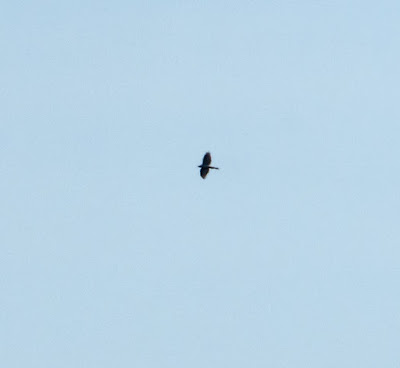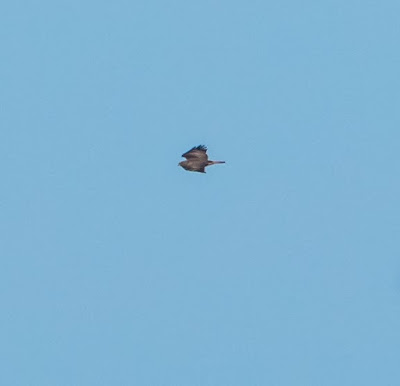Ever since joining the
Wildfowl and Wetlands Trust at
Caerlaverock WWT in Dumfries I've been thinking about going to
Slimbridge WWT near Bristol. After all it is widely regarded as the birthplace of modern conservation where its founding father,
Peter Scott, first established the Wildfowl and Wetlands Trust as well as the place where he introduced the general public to nature and the countryside via some of the earliest natural history TV broadcasts. However, it always seemed quite just a little too far to go for a day trip.
Well, as the opportunity arose of tying it in with a trip to see the
Blue Rock Thrush at
Stow-on-the-Wold as well as some
Hawfinches that had been showing well at
Parkgate in the
Forest of Dean, I decided to book into a hotel for the night in
Gloucester and go for it.
After visiting the Blue Rock Thrush at Stow, I headed straight for
Slimbridge and arrived there in the early afternoon. My target species were the
Bewick Swans (on which so much work was done here by Peter Scott), the
Eurasian White-fronted Geese and the
Cranes which have been successfully breeding here. Luckily, I managed to get all three, but only just.
I started off asking where things were at the information desk and was soon on my way towards the
Holden Tower which overlooks the banks of the
River Severn. There are many hides along the way and I first saw the
Cranes from the
Martin Smith Hide where four were actively grooming themselves. It was a real shame that they were wearing such large leg rings - know and understand the reasons for them, but I still don't like them very much. I didn't actually stay very long here as I'd previous seen my first Cranes only a few weeks ago in Norfolk.
There are two subspecies or 'races' of White-fromted Goose - the Greenland race and the Eurasian race. The name of the race originates form where they breed and so the Greenland race is usually found a lot further north, such as in Scotland.
Therefore I spent most of my time photographing the industrious rooks which were busy nest building in the tall trees behind the hide. One particular bird had found a piece of branch that was far too long to carry, but it wouldn't give up trying and was very amusing to watch.
I continued to the
Holden Tower where I got quite excited about a flock of Barnacle Geese feeding on the grass before I was informed that they were feral birds which never leave the area. Oh, well. There were also plenty of
Greylag Geese about and I sane these are feral here too. Holden Tower gives a good view across this part of the reserve and there were plenty of Wigeon, Shelducks and Tufted Ducks to see as well as another view of the White-fronted Geese.
So next it was on to the other side of the reserve to reach the
Zeiss Hide in order try to find the
Bewick's Swans which had been reported there. Bewick's Swans are actually a subspecies of
Tundra Swan and they are the smallest swan in Europe.

Slimbridge is a stronghold for Bewick's Swans and it is here the Peter Scott first drew his famous diagrams of their various bill patterns.
Compared to Whooper Swans their black beaks sport a small yellow blob, rather than the Whooper's extended yellow wedge.
These yellow and black beak patterns have been extensively studied and illustrated over the years and are unique to each swan, identifying individual birds.
I would have liked to see Peter Scott's original drawings but apparently they are not on display anywhere at the moment.
By now most of the Bewick's Swans had moved back to their breeding grounds in the cold Arctic tundra of northern Russia but a small family party of five birds was reported as still being around together with a sixth juvenile straggler which seems to have been left behind. But I had no luck finding any of there here. I had also been informed that they had been seen in the fields approaching the reserve, so I decided to look there on my way out.
Therefore I spent most of my time photographing the industrious rooks which were busy nest building in the tall trees behind the hide. One particular bird had found a piece of branch that was far too long to carry, but it wouldn't give up trying and was very amusing to watch.

It was starting to get late and I was getting worried that I might not get to see everything, so I hurriedly walked through the captive bird collections to get to the South Lake which is good for waders. I wasn't disappointed here as there were large flocks of
Avocets and
Black-tailed Godwits, a
few
Snipe and some nice singletons including a distant
Spotted Redshank, a
Mediterranean Gull and an immature male
Goldeneye.
On the way back to the car I spotted the wild Black Swan with no rings that had reportedly flown in recently and I wondered how long before these are accepted on the British List.
On driving out of the reserve I was flagged down by someone to whom I had been chatting on the car park just before I left. He'd spotted the Bewick's Swans in the field that I had talked to him about and so was keen to let me know he'd found them. We had great views in the early evening sunlight.
But to cap it all, just as I was about to go two
Cranes flew across the back of the same field and then towards us and over the road into the next field. I fruststratedly fiddled with my camera trying to delete some some shots as I just completely filled my memory card with shots of the Bewick's, but it was too late - they'd gone! Nevertheless they were a great sight on which to finish my successful afternoon here at Slimbridge.

























































